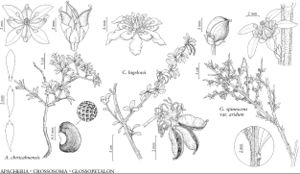Shrubs, rarely trees. Stems intricately branched, often spinescent; bark becoming finely and irregularly grooved, usually peeling in thin longitudinal plates. Leaves deciduous or drought-deciduous, cauline, alternate or opposite, sometimes appearing fasciculate on short-shoots, simple; stipules absent or relatively small; petiole absent or short, base usually slightly expanded, thickened and persistent (in Glossopetalon); blade herbaceous to slightly coriaceous, margins entire or apically 2–3-lobed (in Apacheria). Inflorescences terminal on short-shoots, sometimes axillary or appearing so, usually flowers solitary, occasionally 2–3-flowered clusters (in Glossopetalon), short-shoots or pedicels usually with minute, scarious or hardened bractlike structures at base. Flowers bisexual, perianth and androecium perigynous; epicalyx bractlet absent; hypanthium saucer-shaped to shallowly cupshaped [narrowly funnelform (in Velascoa)]; sepals (3–) 4–5 (–6), distinct; petals (3–) 4–5 (–6), distinct, base often short-clawed; nectar disc absent or crenately lobed, fleshy or thin; stamens 4–50, distinct, sometimes unequal in length, anthers attached at or near bases, yellow, dehiscing by longitudinal slits; pistils 1–9, distinct, free, short-stipitate or sessile, styles usually ± oblique, often indistinct, stigmas capitate or relatively short, sometimes linear, ventrally decurrent; ovules 1–22+. Fruits follicles, angled or short-tapered at both ends, coriaceous. Seeds 1–22 per follicle, arillate.
Distribution
w United States, Mexico
Discussion
Genera 4, species ca. 8 (3 genera, 7 species in the flora).
For years, Crossosomataceae were thought to comprise only the type genus. In 1975, the circumscription was expanded with the discovery of Apacheria, and three years later it was enlarged further with the transfer of Glossopetalon from the Celastraceae (R. F. Thorne and R. Scoggin 1978). A fourth genus, the monospecific Velascoa Calderón & Rzedowski, endemic to northeastern Querétaro, Mexico, was described in 1997. Velascoa recondita Calderón & Rzedowski is unique in the family in its elongate, narrowly funnelform hypanthium and nearly sessile stamens.
The affinities of the family have been controversial. A. Cronquist (1981) outlined the problems, noting that the presence of an aril (and some embryologic features) suggested a placement in the Dilleniales, but he chose instead to classify the family tentatively in his concept of Rosales, near the Rosaceae, based on superficial floral similarities such as perigyny. V. Sosa and M. W. Chase (2003), who studied DNA sequence variation, and M. L. Matthews and P. K. Endress (2005), who studied developmental floral morphology, independently concluded that the Crossosomatales should be segregated as a distinct order (including such morphologically diverse families as Stachyuraceae and Staphyleaceae). The circumscription and placement of this order in relation to other Rosids are still uncertain.
Selected References
None.
Lower Taxa
Illustrations
| Family ⠉ | Taxon | Illustrator ⠉ | |
|---|---|---|---|
 | Crossosomataceae Crossosomataceae Crossosomataceae | Apacheria chiricahuensis Crossosoma bigelovii Glossopetalon spinescens var. aridum | Barbara Alongi Barbara Alongi Barbara Alongi |
Key
| 1 | Stamens 15–50; sepals and petals 5; petals 9–18 mm; follicles finely transversely verrucose or indistinctly reticulate; seeds 4–22 per follicle; aril deeply fimbriate. | Crossosoma |
| 1 | Stamens 8 or 4–10; sepals and petals 4 or 3–5(–6); petals 4–5 mm or 2–9 mm; follicles longitudinally striate; seeds 1 or 2 per follicle; aril irregularly discoid or ± fimbrillate | > 2 |
| 2 | Leaves opposite, sometimes appearing fasciculate on short shoots, blade margins entire or apically 2–3-lobed; stigmas linear; sepals and petals 4. | Apacheria |
| 2 | Leaves alternate, blade margins entire; stigmas capitate, oblique; sepals and petals 3–5(–6). | Glossopetalon |